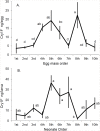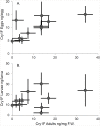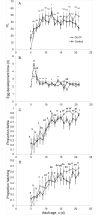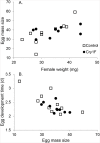Sequestration and Transfer of Cry Entomotoxin to the Eggs of a Predaceous Ladybird Beetle
- PMID: 26661738
- PMCID: PMC4682807
- DOI: 10.1371/journal.pone.0144895
Sequestration and Transfer of Cry Entomotoxin to the Eggs of a Predaceous Ladybird Beetle
Abstract
In the past 10 years, sequestration of Cry toxins and transfer to offspring has been indicated in three insect species in laboratory studies. This work directly demonstrates the sequestration and intergenerational transfer of Cry1F by the parents of the aphidophagous coccinellid predator, Harmonia axyridis, to its offspring. Recently emerged adults (10 individual couples/cage/treatment) were exposed during 20 days to aphids (100 Myzus persicae each day) that fed on a holidic diet containing 20 μg/mL Cry1F (and a control-group). Egg batches and neonate larvae were monitored daily, and counted and weighed for immunodetection of Cry1F by ELISA. At the end of the bioassay, the parents were weighed and analyzed by ELISA. Cry1F was detected in the offspring, both eggs and neonate larvae, of exposed H. axyridis adults. On average the neonate larvae had 60% of the Cry1F concentration of the eggs from the same egg batch. The Cry1F concentration in the adults was positively correlated with the concentration in their eggs. These three results provided independent evidence of transfer to offspring. No detrimental effects of Cry1F were observed on the age of first reproduction, total number of eggs laid per female, age-specific fecundity, egg development time, hatching rate, or fertility rate. The occurrence and generality of intergenerational transfer of Cry toxins should be investigated in the field to determine its potential ecological implications.
Conflict of interest statement
Figures




Similar articles
-
Uptake and bioaccumulation of Cry toxins by an aphidophagous predator.Environ Pollut. 2016 Feb;209:164-8. doi: 10.1016/j.envpol.2015.11.036. Epub 2015 Dec 10. Environ Pollut. 2016. PMID: 26686057
-
Fate of multiple Bt proteins from stacked Bt maize in the predatory lady beetle Harmonia axyridis (Pallas) (Coleoptera: Coccinellidae).Environ Pollut. 2021 Jan 1;268(Pt B):115421. doi: 10.1016/j.envpol.2020.115421. Epub 2020 Aug 15. Environ Pollut. 2021. PMID: 33157396
-
Limitations in dose-response and surrogate species methodologies for risk assessment of Cry toxins on arthropod natural enemies.Ecotoxicology. 2016 Apr;25(3):601-7. doi: 10.1007/s10646-016-1619-9. Epub 2016 Feb 4. Ecotoxicology. 2016. PMID: 26846212
-
Development and application of molecular gut-content analysis to detect aphid and coccinellid predation by Harmonia axyridis (Coleoptera: Coccinellidae) in Italy.Insect Sci. 2015 Dec;22(6):719-30. doi: 10.1111/1744-7917.12165. Epub 2014 Dec 15. Insect Sci. 2015. PMID: 25164698
-
Evolutionary ecology of microsporidia associated with the invasive ladybird Harmonia axyridis.Insect Sci. 2015 Mar;22(3):313-24. doi: 10.1111/1744-7917.12159. Epub 2014 Nov 26. Insect Sci. 2015. PMID: 25131382 Review.
Cited by
-
Transfer of Cry1F from Bt maize to eggs of resistant Spodoptera frugiperda.PLoS One. 2018 Sep 12;13(9):e0203791. doi: 10.1371/journal.pone.0203791. eCollection 2018. PLoS One. 2018. PMID: 30208091 Free PMC article.
References
-
- James C. Global status of commercialized biotech/GM crops: 2014 ISAAA Brief 2014; No. 49. ISAAA: Ithaca, NY.
-
- Lövei GL, Andow DA, Arpaia S. Transgenic insecticidal crops and natural enemies: a detailed review of laboratory studies. Environ Entomol. 2009; 38(2): 293–306. - PubMed
-
- Arpaia S. Genetically modified plants and non-target organisms: analyzing the functioning of the agro-ecosystem. Collection of Biosafety Reviews (ICGEB Biosafety Unit) 2010; 5: 2–80.
-
- Zhang G-F, Wan F-H, Lovei Gl, Liu W-X, Guo J-Y. Transmission of Bt toxin to the predator Propylaea japonica (Coleoptera: Coccinellidae) through its aphid prey feeding on transgenic Bt cotton. Environ Entomol. 2006; 35: 143–150.
Publication types
MeSH terms
Substances
LinkOut - more resources
Full Text Sources
Other Literature Sources
Miscellaneous

